LSU Pivotal Football Moments
pivotal college football moment: A decision by a coach or athletic director that changes the momentum of a program or an action by a player that changes the momentum of a game.
pivotal college football moment: A decision by a coach or athletic director that changes the momentum of a program or an action by a player that changes the momentum of a game.
On October 11, 1924, LSU played its first game against a school from the Western Conference (forerunner of the Big Ten). Mike Donahue's Tigers traveled 24 hours by train to Indianapolis to play the Indiana Hoosiers.
The day of the game was proclaimed "Dixie Day" in Indy, and a crowd of 12,000 filled the baseball field stands "to see Indiana take the Tigers like 'Grant took Richmond'" (to quote the impassioned prose of LSU's 1924 Yearbook). Almost all were Hoosier faithful except for the LSU Cadet Band that had traveled with the team. Back home, Tiger rooters gathered at State Field (precursor of Tiger Stadium) to follow the action by wireless on the GridGraph mounted on a stage and narrated by "Wild Bill" Graham.
"Beneath a summer sun which brought memories of Louisiana home to the men," the crowd of 25,000 watched the Tigers start badly when Daniel Bernoske, Indiana's "speedy lineman," picked up a fumble and ran for a touchdown. The PAT made it 7-0 Indiana less than two minutes into the game.
LSU responded with a 60y touchdown drive of their own using their "celebrated 'Line Divide' formation." Allen Connell's 15y scoring run should have tied the score, but the PAT failed. Indiana 7 LSU 6
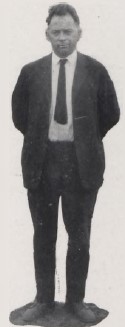

L: Coach Mike Donahue; R: LSU's "Line Divide" offense attacks the Indiana defense.
(LSU Gumbo Yearbook Class of 1925)
Tigers Capitalize on Fumble
The third quarter began with the Hoosiers leading 14-6. But the Tigers took advantage of a break when future judge and LSU Board member Oliver "Ike" Carriere ("the game little quarterback and lightest man on the team") made amends for his earlier bobble that set up Indiana's first touchdown by recovering a fumble on the Indiana 42.
Two plays later, junior HB Norman Stevens burst 38y to pull LSU within one as hats flew and cheers erupted 850 miles away in Baton Rouge.
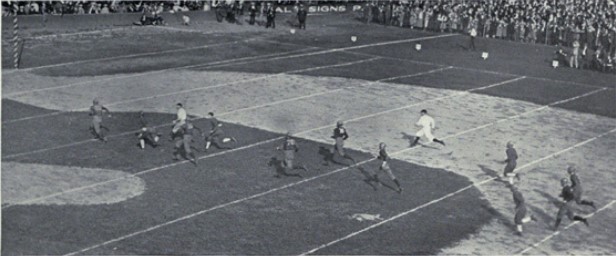
Norm Stevens runs for LSU touchdown. (Indiana University Arbutus Yearbook Class of 1925)
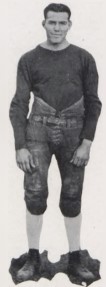
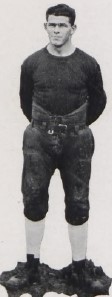

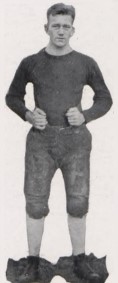
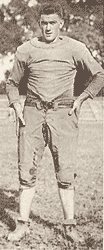
L-R: Ike Carriere, Gus Jackson, Norman Stevens, Ben Miller, Opie Dimmick
(LSU Gumbo Yearbook Class of 1925)
More exultation back home when LSU methodically drove 67y in the final period to score on a short run by Gus Jackson for a 20-14 lead.
Goal Line Stand Stops IU's Last Chance
However, IU roared back, opening up a desperate pass attack. Victor Salmi connected with Frank Sibley for 25y and threw another pass to Templeton Smith for 11. Salmi then called his own number for 10y and a first down on the 12. Smith got three over left tackle before Salmi gained four and then two at the same spot for a first down at the two.
Salmi carried again. No gain. Smith rammed center. No gain. Salmi took another turn through the center. No gain. Donahue sent in several substitutes. IU captain Joe Sloate took the ball on fourth down, but junior E Ben Miller broke through to nail the ball carrier on the five. LSU ball!
After Charles Forgey gained 4y, Carriere asked Miller to punt the ball out of danger. He booted his first collegiate punt to midfield and then made the tackle just before time ran out.
Coach Donahue was afraid to look as Miller punted, but when the horn sounded, the little Irishman ran onto the field and shook the hands of his weary warriors.
Bedlam broke out in Baton Rouge. Hats flew in the air, and cheers rang out.
The victory removed the goat horns from QB Opie Dimmick. In the third quarter, upon intercepting a pass, he paused to yell to the stands "Bound for Dixie!" The delay allowed him to be overtaken on the IU six and cost LSU a touchdown.
Dimmick's boo-boo was not only forgiven by Donahue but provided the main topic of conversation on the train ride back to Baton Rouge.
The Indiana 1925 yearbook summarized the game like this:
Louisiana's tough crew, masquerading under the docile and mild name of "Pelicans," came back in the final quarter of the intersectional game at Washington Park to win a heart-breaker 20-14. Three thousand frantic Crimson rooters, urging the team on to a comeback that failed but one yard from the Louisiana goal in the last minutes of play, sorrowfully heard the gun end sixth minutes of the strongest offensive play they ever had seen.
Reference
The Fighting Tigers II: LSU Football 1893-1980, Peter Finney (1980)
The Fighting Tigers II: LSU Football 1893-1980, Peter Finney (1980)